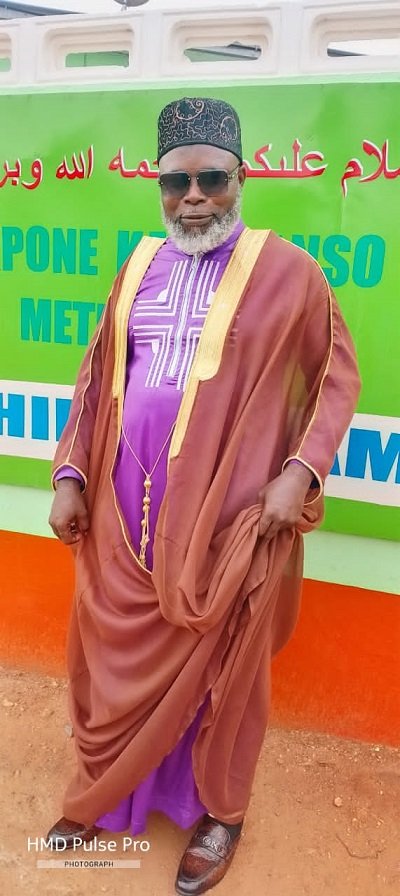Fruitful Living
Power over Satan and demons (Part two)
JESUS AND DEMONS1)
The New Testament frequently describes individuals who are suffering from Satan’s oppression and influence due to evil spirits that take up residence in their bodies and gain control of their lives. Throughout the Gospels (the narrative accounts of the “good news” and the true story of Jesus Christ), Jesus shows His power and authority to free people from this spiritual slavery. The Gospel of Mark, describes many times in which Jesus comes in contact with and stands against demons with the power of God: “That evening after sunset the people brought to Jesus all the sick and demon-possessed. The whole town gathered at the door, and Jesus healed many who had various diseases. He also drove out many demons, but he would not let the demons speak because they knew who he was.” – Mark 1:32-34.
“Just then a man in their synagogue who was possessed by an impure spirit cried out, 24 “What do you want with us, Jesus of Nazareth? Have you come to destroy us? I know who you are—the Holy One of God!” “Be quiet!” said Jesus sternly. “Come out of him!” The impure spirit shook the man violently and came out of him with a shriek. – Mark 1:23-26.
2) In His miracles, Jesus often attacks the power of Satan and demonic forces. Jesus states clearly that one of His purposes in coming to earth was to destroy the works of Satan and to set free those the devil holds as slaves.
3) One way Jesus binds and destroys Satan’s power is by driving out demons (by His authority, forcing them to leave the person’s body and give up control of the individual’s life). But he paid the penalty for our sin. This victory shattered the power of Satan’s kingdom and restored the power of God’s kingdom in people’s lives. Jesus’ work and personal sacrifice made Satan’s defeat certain and gained God’s victory over him.
4) Hell, the place of eternal punishment, torment and separation from God, has been prepared by God for the devil and his demons. “Then He will say to those on his left, ‘Depart from Me, you who are cursed, into the eternal fire prepared for the devil and his angels.” – Matthew 25:41
BELIEVERS AND DEMONS
1. God’s Word teaches that because God’s Holy Spirit lives within each true follower of Christ, a Christian cannot be demon-possessed. God’s Spirit and demons can never live in the same body. Demons may, however, influence the thoughts, emotions and actions of Christians who fail to follow and respond to the leading of the Spirit.
2. Jesus promised His followers that they would have authority over the power of Satan and demons. As we confront them, we must rely on Jesus and use His authority to break the power that demonic forces want to force upon us and others. This means we must wage intense spiritual warfare through the power of the Holy Spirit. The power of God is the only source that frees us from the power and influence of the devil’s darkness and brings us into God’s spiritual light with victory.
3. According to the parable in Mark 3:27 – “In fact, no one can enter a strong man’s house without first tying him up. Then he can plunder the strong man’s house.” Spiritual conflict against Satan and his demonic forces involves three stages of spiritual battle:
a) Declare war against Satan according to God’s purpose.
b) Enter Satan’s territory (any area of life where he has a “strong hold” or has strongly forced his evil control), then attack and overpower him through prayer and God’s Word. By doing this, God will destroy the devil’s weapons of deception and temptation.
c) Take what the devil possesses. This means helping to liberate those who have been enslaved by Satan’s power and helping to restore them to God so that they may receive forgiveness and new life through faith in Christ.
4. As we boldly embrace the authority and power of God, we should take the following steps in our spiritual battle:
a) Recognise that we are not in a conflict against flesh and blood (human persons, powers and purposes). Rather, we are fighting against spiritual forces and powers of evil.
b) Remain deeply committed to God’s truth and to living by the standards of His Word.
c) Have faith that Satan’s power can be broken in any specific area where he might have control. We must also realise that God has given Christ’s followers powerful spiritual weapons for the destruction of Satan’s strongholds.
d) Boldly proclaim the message of Christ and His kingdom (His highest power, authority, purposes and way of life) through the empowerment of the Holy Spirit.
e) Challenge Satan and his power directly by relying completely on Jesus and taking authority in his name, using God’s Word, praying in the Spirit, fasting and driving out demons.
f) Praying particularly that the Holy Spirit would work in the consciences of people who are spiritually lost (who have not accepted forgiveness from Christ and do not have a personal relationship with God). Only the Holy Spirit can truly convince them of their sin, the truth of God’s Word and the fact that they will be judged by God’s standards.
g) Desire, pray for and expect the Holy Spirit to be active in your life, your ministry and your church through His spiritual gifts (special abilities and empowerment He gives for the purpose of building Christ’s church and encouraging those who are a part of it). Among these gifts are healing, prophecy, tongues, miracles, signs and wonders.
CONCLUSION
It cannot be emphasised enough that we must be in a right relationship with God and fully equipped to do spiritual battle by spending time in prayer and God’s Word. We must have a deep understanding of God and His Word, and we must be actively growing in all spiritual areas of our Christian life. Doing this is important because we are no match for Satan’s powers on our own. Christ’s followers must pray constantly and remain spiritually alert, relying on God’s strength and resources to recognise and conquer Satan’s evil schemes and to maintain a strong faith. They must also rely on God so that when they do come face to face with demonic powers, they will be able to fearlessly exercise Jesus’ authority over them.
This article is culled from the FIRE BIBLE: Global Study Edition.
Stay blessed!
For further inquiries please contact us on Tel Nos. 0302-772013 or 0268130615
Email: saltnlightministries@gmail.com
Website: saltandlightministriesgh.org
Fruitful Living
Eid-ul-Adha: A living legacy of faith, sacrifice, and devotion

We begin in the name of Allah, the Most Merciful, the Most Compassionate. We praise Him, seek His help and forgiveness, and seek refuge in Him from the evils of our souls and the wrongs of our actions.
May peace and blessings be upon the Prophet Muhammad (peace be upon him), his family, his noble companions, and all those who follow his path until the Day of Judgment.
Understanding the essence
of Eid-ul-Adha
Eid-ul-Adha, the Festival of Sacrifice, is one of the two major Islamic celebrations observed by Muslims across the world.
It commemorates the unwavering submission of Prophet Ibrahim (Abraham, peace be upon him) to Allah’s command when he was prepared to sacrifice his beloved son Isma’il (Ishmael, peace be upon him). Allah, in His infinite mercy, intervened and replaced the son with a ram, thus honouring Ibrahim’s sincerity and faith.
This moment of sacrifice is recorded in the Qur’an: “Then when they had both submitted and he put him down upon his forehead, We called out: ‘O Ibrahim! You have fulfilled the vision.’ Indeed, We thus reward the doers of good.” (Surah As-Saffat, 37:103–105)
This act of obedience is not merely a historical account. It is a living symbol that forms the essence of Eid-ul-Adha.
Ibrahim (A.S): The Architect
of Submission
Before the moment of sacrifice, Prophet Ibrahim and his family played critical roles in establishing Islam’s foundational pillars:
1. The building of the Ka‘bah
Prophet Ibrahim and his son Isma’il were chosen to construct the Ka‘bah, the sacred House of Allah in Makkah. The Qur’an records this noble moment:
“And [mention] when Ibrahim was raising the foundations of the House and [with him] Isma’il, [saying], ‘Our Lord, accept [this] from us. Indeed, You are the Hearing, the Knowing.’”
(Surah Al-Baqarah 2:127)
This structure remains the spiritual centre of Muslim worship, facing which over a billion Muslims direct their daily prayers.
2. The struggle of Hajar (Hajara) between Safa and Marwa
The mother of Isma’il, Hajar (Hajara), exemplifies a profound lesson of patience and faith. Left in the barren valley of Makkah with her infant, she ran between the hills of Safa and Marwa, desperately searching for water. Her perseverance was rewarded when the well of Zamzam sprang forth at the feet of her baby.
Her sincere struggle is now ritualised in Hajj as the Sa‘i between Safa and Marwa—a reminder of the role of women, the power of du‘a, and the value of trust in Allah’s provision.
Sacrifice at Mina and the
Rites of Jamarat
During Hajj, pilgrims reenact Ibrahim’s confrontation with Shaytan at Mina, where he rejected the devil’s temptation and cast stones at him. This act is now observed in Hajj as the ritual of stoning the Jamarat, symbolising the rejection of evil, temptation, and disobedience.
It is a vivid spiritual lesson: the path to Allah is one of resistance to distraction and sin, and one must be prepared to fight these forces with unwavering faith.
The essence of Arafat in Hajj
The Prophet Muhammad said:“Hajj is Arafah.” (Sunan al-Tirmidhi, 889)
Standing on the plain of Arafat, in deep humility and supplication, is the heart of Hajj. It represents the Day of Judgment, when all of humanity will stand before their Creator. The Prophet said: “There is no day on which Allah frees more people from the Fire than the Day of Arafah.” (Sahih Muslim, 1348)
For pilgrims, Arafat is a time of repentance, reflection, and renewal— and for non-pilgrims, fasting on that day is highly recommended.
Three core lessons from the
Sacrifice of Prophet Ibrahim
(A.S.)
1. Absolute obedience to Allah
Ibrahim’s willingness to sacrifice his son teaches that the essence of faith is unquestioning obedience to Allah. He prioritised divine command over emotion, logic, or comfort.
Takeaway:
In our lives, we must also be ready to put aside our desires, egos, and even attachments if they conflict with Allah’s instructions. This may involve sacrifices such as waking up for Fajr, staying away from haram income, or being truthful in difficult situations.
2. Sincere intention and inner sacrifice
The real essence of the sacrifice lies in the heart’s submission to Allah.
It is neither their meat nor their blood that reaches Allah, but it is your piety that reaches Him.”
(Surah Al-Hajj 22:37)
Takeaway:
Every act of worship should be grounded in sincerity. Whether it is prayer, charity, or sacrifice, what matters most is the purity of our intention.
3. Sacrifice for the greater good
The legacy of Eid-ul-Adha teaches us that sometimes, faith requires us to give up what we love for a greater purpose. Sacrificing wealth, time, or status in the path of Allah or for the benefit of others leads to spiritual elevation.
Takeaway:
Use your resources such as time, money, skills, for acts of benefit: support the poor, educate the young, assist the sick, and build your community.
Celebrating Eid-ul-Adha: A
Festival for all Muslims
Even for those who do not go on Hajj, Eid-ul-Adha holds immense significance. Muslims across the world participate in the act of Qurbani (sacrifice) to honor the tradition of Ibrahim (A.S.).
Types of animals and their
symbolism
Permissible animals include goats, sheep, cows, and camels. Each must meet a minimum age and be free of defects. The sacrificed animal is then divided into three parts: one for the family, one for relatives and friends, and one for the poor and needy.
This distribution reflects the spirit of sharing, compassion, and social responsibility—values at the heart of Islam.
The eternal message of Eid-ul-Adha
Eid-ul-Adha is not merely a celebration; it is a living tradition that calls us to:
• Submit like Ibrahim,
• Strive like Hajar,
• Sacrifice like Isma’il,
• Reflect like the pilgrims at Arafat.
May this Eid awaken within us a renewed commitment to obedience, sincerity, and compassion.
Let us make every Eid-ul-Adha a step forward in our spiritual journey, embodying the values of submission, sacrifice, and service to humanity. I wish every Muslim Eid Mubaarak
By Imaam Alhaji Saeed Abdulai
(Kpone Katamanso Metropolitan Chief Imaam)
Fruitful Living
Steps taken by government to combat illicit drugs (Final part)
The Minister for the Interior, Muntaka Mohammed-Mubarak, has reaffirmed the government’s commitment to combating drug abuse and illicit trafficking for a safer environment which would
go a long way to make Ghana a drug-free country. 3News.com (2025)
Solutions to Illicit Drugs from the Islamic perspective
are comprehensive and emphasise of both prevention and treatment:
Tarbiyah (Islamic nurturing): Instilling strong Islamic values from childhood through Qur’anic education, regular prayer, and association with righteous companions.
Community preaching (Da’wah): Imams must consistently raise awareness during khutbahs and Islamic programs about the dangers of drugs and the beauty of a sober, productive life.
Faith-based rehabilitation: Mosques and Islamic centers can partner with medical institutions to offer Qur’an therapy, spiritual counseling, and structured recovery programs.
Islamic youth clubs: Providing youth with halal entertainment, mentorship, and purposeful engagement can steer them away from harmful peer groups.
Zakat and Sadaqah: Channelling funds to support families of victims and establishing centres for rehabilitation.
Role of Parents, Society, Muslim Chiefs and Imams:
Parents must be vigilant and provide emotional support. A loving, nurturing home reduces a child’s vulnerability to drugs.
Society should de-stigmatize addiction. Drug users should be seen as patients needing healing, not criminals deserving rejection.
Muslim Chiefs must lead community campaigns, setting moral examples and supporting policy enforcement.
Imams must be more than religious leaders—they must become counsellors, educators, and advocates. Their leadership can shift public perception and guide collective action.
Conclusion
Illicit drugs pose one of the most dangerous threats to our society, undermining our religious values, harming our youth, and destroying our future. The Islamic position is clear and
Unequivocal: such substances are forbidden due to their destructive consequences on all aspects of life. Islam does not merely condemn the act but calls for a holistic response—spiritual, social, and structural.
As a society, particularly as Muslims, we must rise to confront this crisis with faith, compassion, and commitment. We must not only preach against drugs but actively work to rehabilitate victims, educate the next generation, and partner with public institutions to create a society of wellness and righteousness.
Recommendations
1. Introduce Islamic drug awareness education in madrasas and public schools, using Quran and Hadith-based materials to instill moral responsibility.
2. Create partnerships between the Ghana Narcotics Control Commission, Ghana Health Service, and Muslim organisations to develop culturally sensitive rehabilitation centres.
3. Train Imams and teachers in basic mental health and drug abuse counselling to serve as front-line responders in communities.
4. Utilise Friday sermons (khutbahs) nationwide to address the dangers of drug abuse periodically and provide practical steps for prevention.
5. Encourage community surveillance, where parents, chiefs, and youth groups report dealers and suspicious activities to the authorities.
6. Establish mentorship programmes in every Muslim community where successful, drug-free role models mentor youth.
7. Form interfaith coalitions, working across religious lines to tackle the drug menace as a national threat rather than a religious issue.
8. Provide job skills training for rehabilitated victims, helping them reintegrate into society and live dignified, self-sufficient lives.
By Imam Alhaji Saeed Abdulai, the Author







